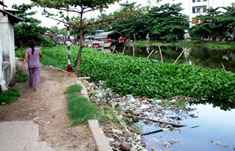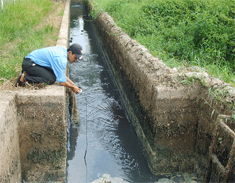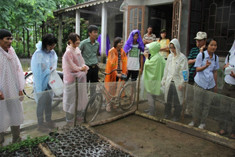Report
Overseas Field Training:Impact of domestic and industrial waste management on water environment in The Mekong River Delta, Vietnam
 |
 |
 |
| A canal in an urban area | Water quality measurement | Receiving an instruction on a project aiming a sustainable agriculture in Bach Ma National Park |
Co Thi Kinh
Department of International Environmental and Agricultural Science Graduate School of Agriculture
Destination and period: Can Tho in Vietnam, 3 Sep. - 16 Sep., 2012
It was our great oppotunity to have an overseas field training in Vietnam in 2 weeks in September 2012, which we had learnt knowledge
about industrial wastewater treatment and management, the impact of domestic and industrial wastewater on surface water quality in
the Mekong River as well as some particular visits for experience the impacts of human on natural resources and environment. Many
study sites in Can Tho city and Thua Thien Hue province, including factories in Tra Noc Industrial zone, O Mon landfill, farmers in Hoa An
village, Can Tho University, and Bach Ma National Park have been visited. The results showed that wastewater in seafood processing
factories in Tra Noc Industrial Zone, including before and after treated by wastewater treatment systems had high level of nitrogen,
phosphate, organic matter, E. coli and coliform which were far above the Vietnamese standard for industrial wastewater (QCVN11:2008/
BTNMT). Water pollution indicating parameters of COD, NH4+, and EC in the branches of Hau River water at Can Tho city were much
higher than the limit by Vietnamese standard for surface water quality (QCVN08:2008/BTNMT). It was calculated that every year Can Tho
city has discharged into Hau river 1.2-8.2x107kgCOD.year-1 or 5.5x107kgCOD.year-1 averagely, in which domestic wastewater was 0.63-
1.9x107kgCOD.year-1, and from industrial wastewater was 0.6-6.2x107kgCOD.year-1. Moreover, we also learned about the integrated
farming system called VACB as one of the popular farming systems in the Mekong Delta which contribute to increasing farmer’s income
and environmental protection. Additionally, visiting O Mon landfill was a great chance for us to experience the situation of solid waste
management in Can Tho city, where we could experience the impacts of poor management landfill on local community and surrounding
environment. Finally, a visit to Bach Ma National Park and charcoal project (supported by TUAT) in the buffer zone have clarified us another
aspect of human impact on natural resouses conservation as well as understanding the activities of the charcoal project, which can be
considered as a potentially effective solutions for improving livelihood of local people in buffer zone and reducing the pressure of human
impact on protection of natural reserve area.
Key words: domestic wastewater, industrial wastewater, water pollution, Mekong River Delta